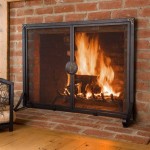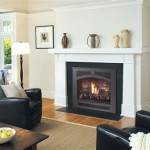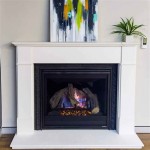Direct Vent Propane Fireplaces: A Comprehensive Guide
Direct vent propane fireplaces offer a convenient and efficient alternative to traditional wood-burning fireplaces. They combine the aesthetic appeal of a fire with the ease of propane fuel and the safety features of a sealed combustion system. These fireplaces are becoming increasingly popular in homes where traditional chimney construction is impractical or undesirable. This article will delve into the mechanics, benefits, installation, and maintenance aspects of direct vent propane fireplaces, providing a comprehensive understanding of this heating appliance.
The core principle behind a direct vent fireplace lies in its sealed combustion chamber. Unlike traditional fireplaces that draw air from inside the home for combustion and vent exhaust gases through a chimney, a direct vent system utilizes a coaxial or co-linear vent pipe. This pipe draws fresh air from outside the house for combustion and expels the exhaust directly outdoors through the same vent system. This sealed system significantly reduces the risk of carbon monoxide poisoning and eliminates the need for a traditional chimney, making installation more flexible and cost-effective.
Propane, as a fuel source, offers several advantages in this context. It burns cleaner than wood, producing fewer particulate emissions. It is also readily available, either through a connection to a municipal propane line or through the use of portable propane tanks. The convenience of propane allows for instant ignition and precise temperature control, features often absent in wood-burning options.
Understanding the Mechanics of Direct Vent Systems
The direct vent system's design is paramount to its safety and efficiency. The vent pipe consists of two concentric tubes. The inner tube expels combustion gases, while the outer tube draws in fresh air. This design allows for a balanced pressure system, ensuring proper combustion and preventing backdrafting of exhaust gases into the home. The sealed firebox further enhances safety by isolating the combustion process from the living space.
The venting system can be installed either horizontally through an exterior wall or vertically through the roof, depending on the fireplace model and the house's architecture. Horizontal venting is often preferred for its ease of installation and lower cost. However, vertical venting may be necessary in certain situations to meet building codes or to achieve a specific aesthetic.
A typical direct vent propane fireplace includes several key components beyond the venting system. These include the firebox, which houses the burner and artificial logs or decorative media; the gas valve, which controls the flow of propane to the burner; the ignition system, which initiates the combustion process; and the control panel, which allows the user to adjust the flame height and heat output. Some models also include a thermostat for automatic temperature control and a blower to circulate warm air throughout the room.
The burner itself is designed to maximize combustion efficiency. It typically consists of a series of ports or openings that distribute the propane gas evenly across the firebox. The shape and arrangement of these ports, along with the design of the artificial logs or media, contribute to the realistic appearance of the flame.
Benefits of Choosing a Direct Vent Propane Fireplace
Direct vent propane fireplaces offer a multitude of benefits compared to traditional wood-burning fireplaces and other heating alternatives. One of the most significant advantages is their efficiency. Because the combustion chamber is sealed, heat loss is minimized, and a greater percentage of the energy from the propane is converted into usable heat. This results in lower heating costs and a more comfortable living environment.
The ease of use is another key benefit. With the push of a button or the flip of a switch, the fireplace can be ignited, providing instant warmth and ambiance. There is no need to chop wood, build a fire, or wait for it to burn down. The flame height and heat output can be easily adjusted to suit individual preferences.
Safety is also a major consideration. Direct vent fireplaces eliminate the risk of sparks, embers, and smoke entering the home. The sealed combustion chamber prevents carbon monoxide from leaking into the living space, and the double-walled vent pipe remains cool to the touch, reducing the risk of burns. These features make direct vent fireplaces a safer option for families with children and pets.
Furthermore, direct vent propane fireplaces offer a wide range of aesthetic options. They are available in various styles, from traditional to contemporary, and can be customized with different log sets, decorative media, and surrounds. This allows homeowners to choose a fireplace that complements their home's décor and creates a focal point in the room.
Installation flexibility is another advantage. Direct vent fireplaces do not require a traditional chimney, making them suitable for homes that lack one or for rooms where chimney construction is impractical. The vent pipe can be run horizontally or vertically, allowing for greater freedom in placement.
Installation and Maintenance Considerations
Proper installation is crucial for the safe and efficient operation of a direct vent propane fireplace. It is recommended to hire a qualified technician who is experienced in installing these types of appliances. The installation process involves several steps, including selecting the appropriate fireplace model and venting system, connecting the gas line, installing the vent pipe, and testing the unit for proper operation.
Before installation, it is important to ensure that the fireplace meets all applicable building codes and regulations. This may involve obtaining permits and having the installation inspected by a local building official. It is also important to verify that the propane supply is adequate for the fireplace's BTU rating.
The vent pipe must be installed correctly to ensure proper venting and prevent backdrafting. The vent pipe should be properly sealed and insulated to prevent heat loss and condensation. It should also be positioned to avoid obstructions and to ensure that exhaust gases are safely dispersed away from the home.
Regular maintenance is essential for keeping a direct vent propane fireplace in good working order. The frequency of maintenance will depend on the amount of use and the specific model, but generally, it is recommended to have the fireplace inspected and serviced annually by a qualified technician.
Maintenance tasks typically include cleaning the burner, inspecting the gas valve and ignition system, checking the vent pipe for obstructions, and cleaning the glass front. It is also important to inspect the artificial logs or decorative media for damage and replace them as needed.
Homeowners can perform some basic maintenance tasks themselves, such as cleaning the glass front with a non-abrasive cleaner and dusting the surrounding area. However, it is important to avoid disassembling the fireplace or attempting any repairs without proper training and experience.
A crucial safety measure is to install and maintain carbon monoxide detectors in the home. These detectors will alert occupants to the presence of carbon monoxide, a colorless and odorless gas that can be deadly. Carbon monoxide detectors should be placed near sleeping areas and tested regularly to ensure they are functioning properly.
In conclusion, direct vent propane fireplaces offer a blend of aesthetics, convenience, and efficiency, making them a compelling option for homeowners seeking a supplemental heating source or a decorative focal point. Selecting the right model, ensuring professional installation, and adhering to a regular maintenance schedule are key to maximizing the benefits and ensuring the safe operation of this appliance.

Direct Vent Gas Stoves In Dc

Vantage Bayview Freestanding Direct Vent Gas Or Propane Fireplace Fireplaces By Cameron

Fire Ribbon Direct Vent Slim Gas Fireplace Spark Modern Fires

Heat N Glo Paloma Direct Vent Gas Stove

What Are Direct Vent Gas Fireplaces Admiral Propane

Thelin Gnome Gas Stove Hearth S Great American Fireplace In Menomonie Wi

Ascent X 42 Direct Vent Fireplace Propane Electronic Ignition

Oxford Direct Vent Gas Stove The Place

Majestic Quartz Series 36 Direct Vent Gas Fireplace Chadwicks S

Majestic Marq42stin Marquis Ii 42 Inch See Through Direct Vent Gas Fireplace








